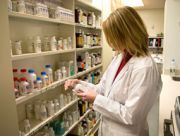Article
Educating Patients about Peptic Ulcer Disease
Author(s):
With 10% of Americans contracting ulcers, pharmacists can be a valuable source of education for patients regarding the causes of peptic ulcer and the pros and cons of available treatments.
This article originally appeared in Pharmacy Times.

One in 10 Americans will develop a peptic ulcer during their lifetime. Until the '70s, ulcers were considered a chronic, relapsing “man’s disease,” erroneously associated with the stress of working hard to support a family and with heavy drinking. Today, however, we know more about the real causes of peptic ulcer disease (PUD) and see that men and women are affected approximately equally. Due to heightened awareness, earlier testing, and infection eradication, PUD’s prevalence, incidence, and related mortality and morbidity have declined in recent years.
Painful Lesions: Description and Causes
PUD is ulceration of an acidic area of the gastrointestinal (GI) tract—either the stomach or duodenum. The esophagus is affected rarely. The combination of increased hydrochloric acid and pepsin and lower GI mucosal defenses allows painful lesions to develop. These mucosal erosions are usually 0.5 cm or larger. PUD is not gastritis or simple erosion, and although it is often confused with these states, its deeper penetration and potential for bleeding make it much more serious. The acidic environment makes ulcers extremely painful. Four times as many peptic ulcers develop in the duodenum as in the stomach, where a small number (~4%) are malignant.
Patients who have chronic inflammation of the GI tract secondary to bacterial colonization with Helicobacter pylori are at elevated risk; this organism causes up to 70% of PUD. H pylori may cause hypergastremia and direct mucosal damage. It is also a risk factor for gastric cancer, so gastroenterologists take biopsies during endoscopy.
People who have heartburn or gastroesophageal reflux disease or are frequent users of NSAIDs alone (including low-dose aspirin) or in combination with glucocorticoids are at high risk for PUD. These drugs cause topical irritation of the gastric epithelial cells and reduce protective prostaglandin synthesis. Risk of perforation and obstruction increases with each year of NSAID use. Lifestyle factors (possibly heavy alcohol intake, smoking), severe physiologic stress (burns, sepsis, multiorgan failure), hypersecretory states, and genetic factors have also been identified as risk factors. Increasing age is an important risk factor. Patients with multiple risk factors—especially age and NSAID use or H Pylori infection and smoking—are at a greatly increased risk.
Visit Pharmacy Times to access the full-text version of this article.





